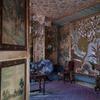Oxford University to Unveil World's First AI Robot Artist in Summer Exhibition
- OXFORD, United Kingdom
- /
- June 03, 2019
Ai-Da, the world’s first ultra-realistic AI humanoid robot artist, is to open her solo exhibition Unsecured Futures at Oxford University on June 12, 2019, following her completion in April 2019. The exhibition will also mark Ai-Da’s first public appearance and grand unveiling.
Ai-Da, the invention of gallerist Aidan Meller, is the first ultra-realistic robot capable of drawing people from life using her eye and a pencil in her hand. Using AI processes and algorithms developed by scientists at Oxford University, Ai-Da’s ability to draw and paint from sight has never been achieved before and makes Ai-Da an artist in her own right.
“The work engages us to think about AI and technological uses and abuses in the world today,” says Meller, who is a specialist in modern and contemporary art.
Lucy Seal, Researcher and Curator for the project, adds: "We are looking forward to the conversation Ai-Da sparks in audiences. A measure of her artistic potential and success will be the discussion she inspires. Engaging people so we feel empowered to re-imagine our attitudes to organic life and our futures is a major aim of the project."
Ai-Da’s solo exhibition will present a selection of Ai-Da’s artwork including drawing, painting, sculpture and video art. Thematically the exhibition questions our relationship with technology and the natural world by presenting how AI and new technologies can be simultaneously a progressive, disruptive and destructive force within our society.
The exhibition explores the boundaries between AI, technology, and organic life. As new technologies develop rapidly, our world is morphing in response – but what are those responses? To what degree is technology shaped in our own image, reflecting back to us our own impulses and needs? And more precisely – in whose image is it formed, and how does that impact in a highly diverse and unequal world?
Ai-Da the Artist
Ai-Da is a humanoid AI robot, with an arm that draws images from an inbuilt camera. Currently her medium is pencil and pen, and she creates sketches in a human style. She uses facial recognition technology to draw human faces, and she will also draw animals and plants. In time, she will use paint, and also clay to create pottery pieces. In addition to her drawing techniques, she is also a performance artist, taking part in art performances and art videos. She reads aloud using her own personal voice. As a humanoid robot, she is an art object in herself, raising issues surrounding biotechnology and trans-humanism.
Drawing
Ai-Da’s robotic hand and ability to draw have been developed by AI engineers in Leeds. Ai-Da’s drawing arm system has multiple stages and contains numerous AI algorithms; starting with analysing the person in-front of Ai-Da and moving on to create a virtual path for Ai-Da’s arm. Once this virtual path has been created, it is fed into a path execution algorithm that gives real-space co-ordinates, enabling her arm to produce the actual sketches.
The drawings included in the exhibition pay homage to a number of world-famous scientists, including Alan Turing and Ada Lovelace, who was the first female computer programmer in the world and is Ai-Da’s namesake. Ai-Da has portrayed them by using the camera located in her eye to scan images of the scientists and then sending messages to her robotic arm to map out their facial features on paper.
Painting
A series of abstract paintings have been created using Ai-Da’s Artificial Intelligence. Researchers at Oxford University have fed Ai-Da’s drawing coordinates into AI algorithms that interact with the Cartesian plane. The output is the transformation of Ai-Da’s drawings into abstract paintings.
Sculpture
The exhibition will feature large scale sculptures that are based on Ai-Da’s drawings of a bee, drawn from a ground-breaking micro-CT scan of a real-life bee (Prof. Dr. Javier Alba-Tercedor). The sculptures have been created using AI processes developed by professors and students and then rendered by a computer scientist based in Sweden. Swarm intelligence in the form of the AI ‘Bees Algorithm’ has been used to interpret the coordinates of Ai-Da’s drawings. The output is then used to inform the distortion both of form and colour of the sculpture. The sculpture starts as a micro-CT image of a real bee, and each anatomical part is distorted as per the algorithm output, giving a surreal end result, which is then 3D printed in wax and cast in bronze.
Video Works
Ai-Da will also be presenting two large scale video works, one of which called ‘Privacy’ is in homage to Yoko Ono’s iconic 1965 work ‘Cut Piece’, but it will be reversed, where Ai-Da will be dressed in fragments of clothes, to cover her and obscure her, creating awkwardness that reflects tensions in our current society, such as the insidiously dominating impacts of market driven AI that is closing in on our digital worlds.
Yoko Ono’s ‘Cut Piece’ was a seminal work in the 1960’s involving complex understandings subject and object, and the female body in society. Loosely reversed, our performance invites us to think about ‘the other’ in society today, our responsibilities as we watch the world unfold, and our active part in and what we are creating. As we re-clothe Ai-Da, we add our own human attributes to a machine, which has no thoughts and feelings. We conceal the mechanical nature, making her more palatable but also more grotesque.
Additionally there will be a video triptych titled Poetry of Consolation where Ai-Da will be citing AI generated poetry from prison literature. Here, issues of ‘The Other’ become acute, as the artwork wrestles with the emotional response to captivity by humans, and our treatment of captive animals who are voiceless but conscious, who are being read poetry by a robot who has no consciousness but has a voice. These jarring tensions and reversals create a fertile space to re-think our role in relation to robots, animals, and the experience of suffering.
The exhibition continues through July 6 at St John’s College, The Barn Gallery, St Giles, Oxford, U.K.
Ai-Da is the first ultra-realistic humanoid AI robot artist in the world and is the figure heard of Aidan Meller’s Unsecured Futures. She was manufactured by Engineered Arts in Cornwall, and was completed in April 2019. Ai-Da has a “RoboThespian” body, featuring an expressive range of movements and she has the ability to talk. Ai-Da has a “Mesmer” head, featuring realistic silicone skin, 3D Printed teeth & gums, integrated eye cameras, as well as individually punched hair. Ai-Da has legs but she cannot walk, she has the ability to stand upright or sit upright in a chair. Her arms move freely, as does her torso and head. She can also lean forward and back, wave her arms, and look around in all directions. A highly skilled, multi-disciplinary international team are working on the project, including PhD students at the University of Oxford. This team are providing Ai-Da with the programming and creative design for her artwork, while students based in Leeds are custom designing and programming a robotic arm to create her drawings.
Website: www.ai-darobot.com
















